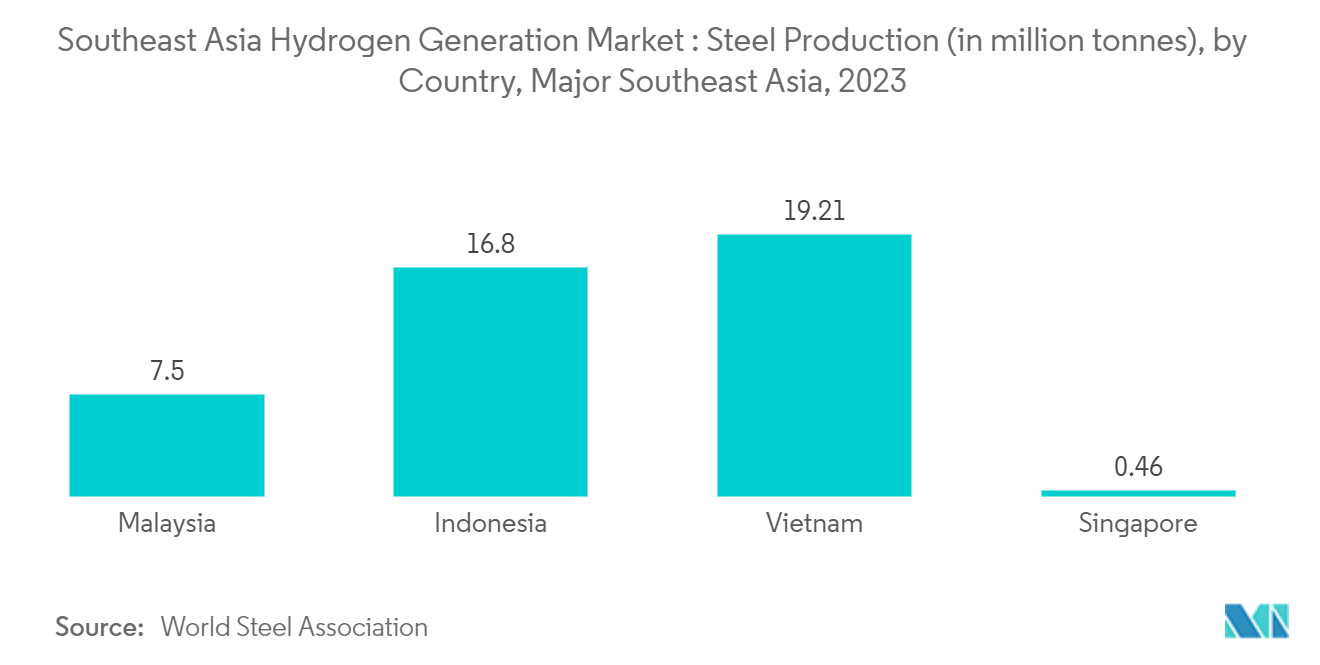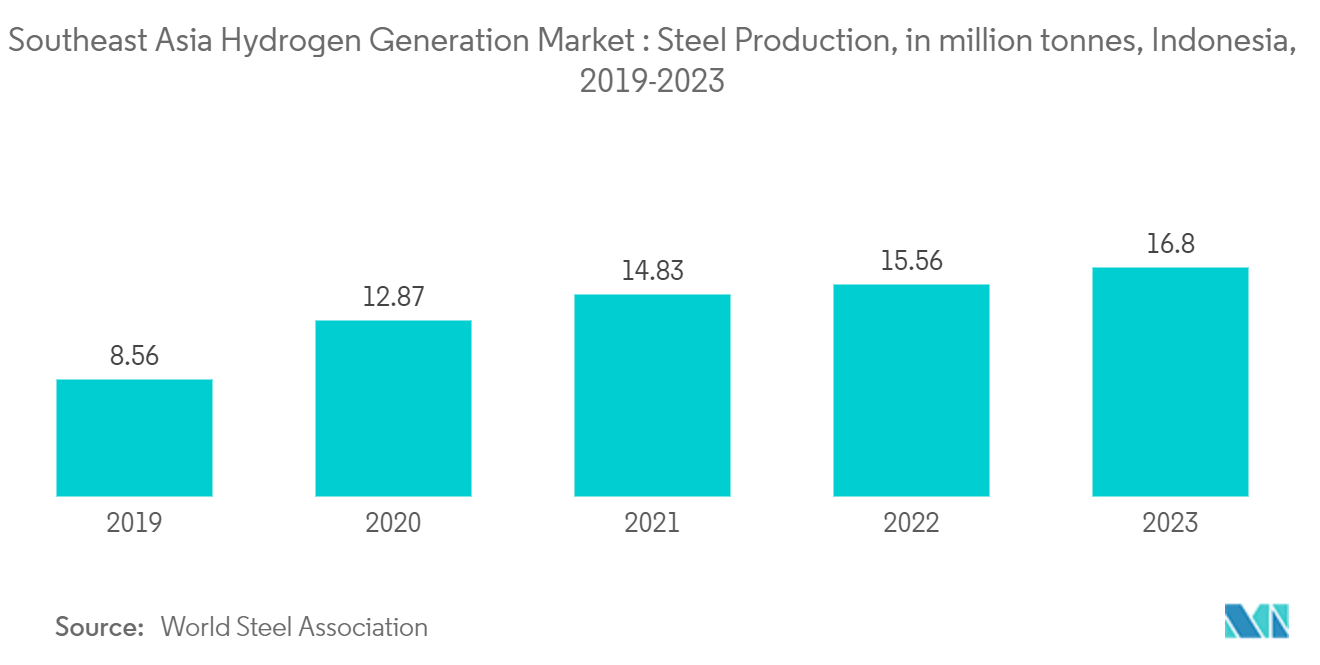Market Trends of Southeast Asia Hydrogen Generation Industry
Grey Hydrogen is a Significant Segment
- Grey hydrogen is the most common form of hydrogen production, and it uses natural gas (via stream methane reformation) or coal (via coal gasification) to produce hydrogen. The process of hydrogen production is a carbon-intensive process, as significant carbon emissions are released into the atmosphere during these production processes.
- According to the Global CCS Institute, approximately 120 Mt of hydrogen is produced annually, of which approximately 98% of current hydrogen production is from the reformation of methane or the gasification of coal or similar materials of fossil-fuel origin (e.g., petcokeor asphaltene). A similar trend is expected to continue in the Southeast Asian region during the forecast period.
- As grey hydrogen is manufactured from fossil fuels using mature technologies, it has one of the lowest manufacturing costs, which other alternatives, such as blue and green hydrogen, cannot compete with. It has been estimated that in regions with low fossil fuel prices, such as the Middle East, Russia, and North America, the cost of grey hydrogen production can dip as low as USD 1/kg H2, while in other regions, such as Europe and Southeast Asian region, the cost is well below USD 2/kg H2.
- The region's attempt to minimize emissions, mainly from heavy industries like petrochemicals, iron and steel, and power generation, are resulting in measures to limit grey hydrogen production and usage. As a result, investments in the industry are fast declining, and capacity growth is likely to be severely limited during the forecast period. Despite lowering costs for blue and green hydrogen technologies, grey hydrogen production is predicted to remain cost-competitive with both types over the forecast period.
- The chemical industry now employs hydrogen gas in relatively limited quantities. Grey hydrogen is used mainly in the steel industry. One kilogram of hydrogen requires 50-55 kWh to generate, while a ton of steel requires 50 kg of hydrogen. Steel output is expected to increase in the upcoming years, with hydrogen playing an important role. Hydrogen helps to reduce the cost of steel.
- Furthermore, in August 2023, Malaysian steelmaker Eastern Steel Sdn Bhd began operation of its newly developed blast furnace, which is expected to increase the company's annual steel production capacity to 2.7 million tons from 700,000 tons. The company has been exporting 40 percent of its steel products to other Southeast Asian countries, including Thailand and Indonesia. The company also intends to install an additional blast furnace with an annual production capacity of 1.3 million tons within the next few years, further expanding its production capacity to 4 million tons. All these types of projects are likely to increase steel production and are expected to increase the demand for hydrogen across the region during the forecast period.
- Therefore, owing to such factors, the grey hydrogen segment is likely to significantly impact the hydrogen generation market during the forecast period.

Indonesia to Witness Significant Growth
- As per the findings in the Indonesia Hydrogen Energy Outlook 2024, by 2060, hydrogen demand in Indonesia is expected to increase to around 2 million tonnes per annum (MTPA) due to increasing demand for Ammonia.
- PT Kilang Pertamina Internasional planned to construct a blue ammonia facility in Bintuni Bay, West Papua Province. The plant is expected to commence operations in 2030, aiming for a blue ammonia production capacity of around 875,000 TPA (tons per annum) of blue ammonia, which is expected to create a demand for blue hydrogen of around 150,000 TPA. The facility is designed to process 90 million standard cubic feet per day (MMSCFD) of natural gas.
- Several nations have started to push research into using hydrogen as an energy source since it has emerged as one of the most promising alternatives to carbon-intensive fuels. A Memorandum of Understanding for a long-term land lease to develop a solar-based green hydrogen production and export facility was signed in October 2022 by Carbon Governance Pte Ltd, a Singapore-based green energy project development company, with a local partner company in Bintan, Indonesia. The export of green hydrogen to Southeast Asia is anticipated to start in the first quarter of 2027, with the Bintan Green Hydrogen project scheduled to attain FID in the fourth quarter of 2023. All these developments/upcoming projects will likely positively impact hydrogen generation in Indonesia during the forecast period.
- Indonesia still needs to establish the required laws and policies to advance its green hydrogen sector. As of right now, just a few pilot projects are using green hydrogen for testing purposes. In any case, Green Hydrogen is believed to be essential to Indonesia's goal of becoming an emission-free nation by 2060. Green hydrogen is a sustainable energy source that is referenced in Indonesia's general national energy plan (RUEN) despite the need for official key policy papers for its development. In addition, the Indonesian Ministry of Energy and Mineral Resources' current renewable energy roadmap indicates that the country's power industry will progressively introduce green hydrogen development starting in 2031 and swiftly accelerate it beyond 2050.
- Steel production in Indonesia is increasing very rapidly. This is another primary reason behind the growth of hydrogen in Indonesia. Hydrogen provides sufficient energy and reduces the cost of steel manufacturing.
- Therefore, based on the above-mentioned factors, Indonesia is expected to witness significant growth in the Southeast Asia hydrogen generation market during the forecast period.


